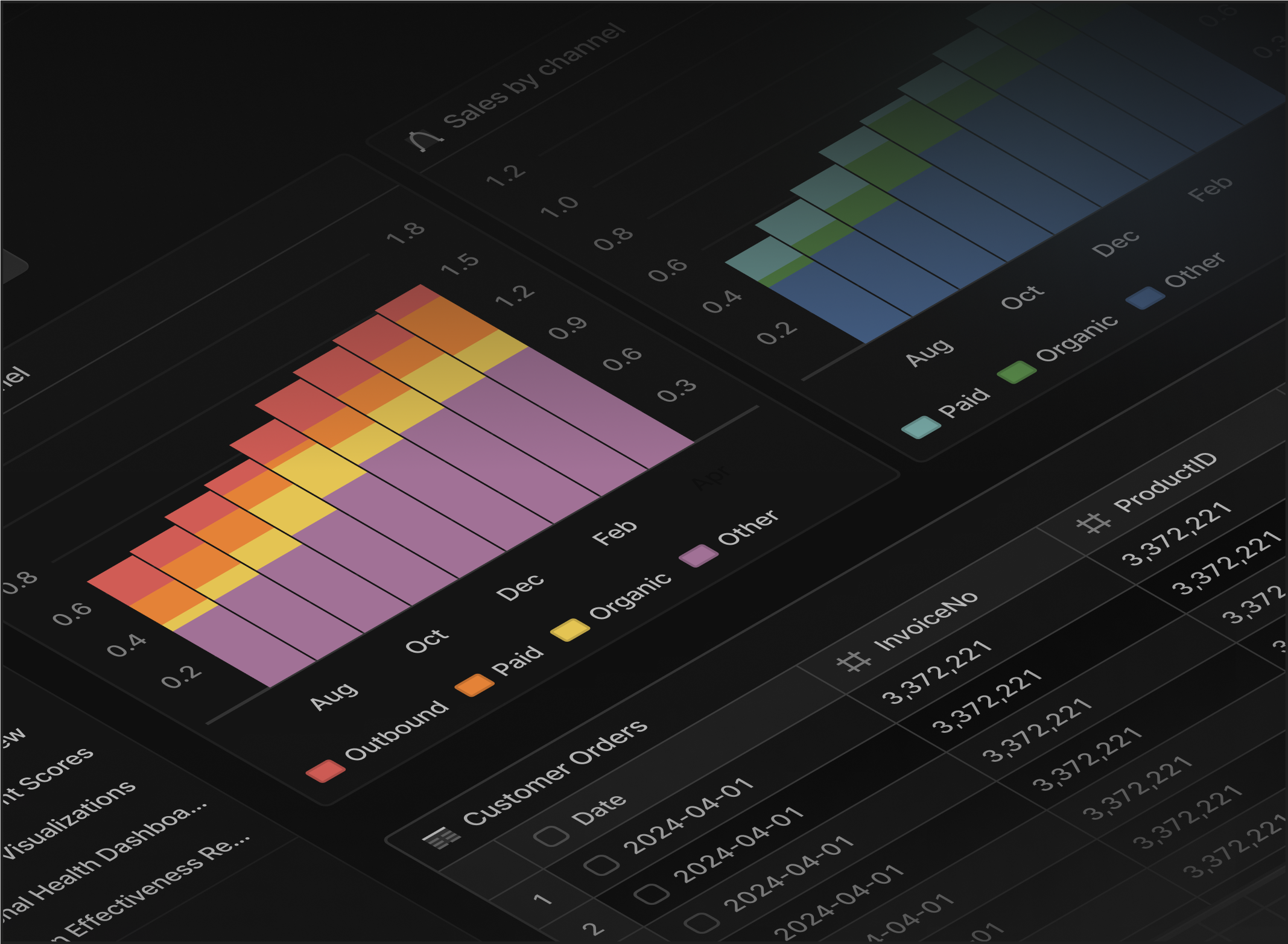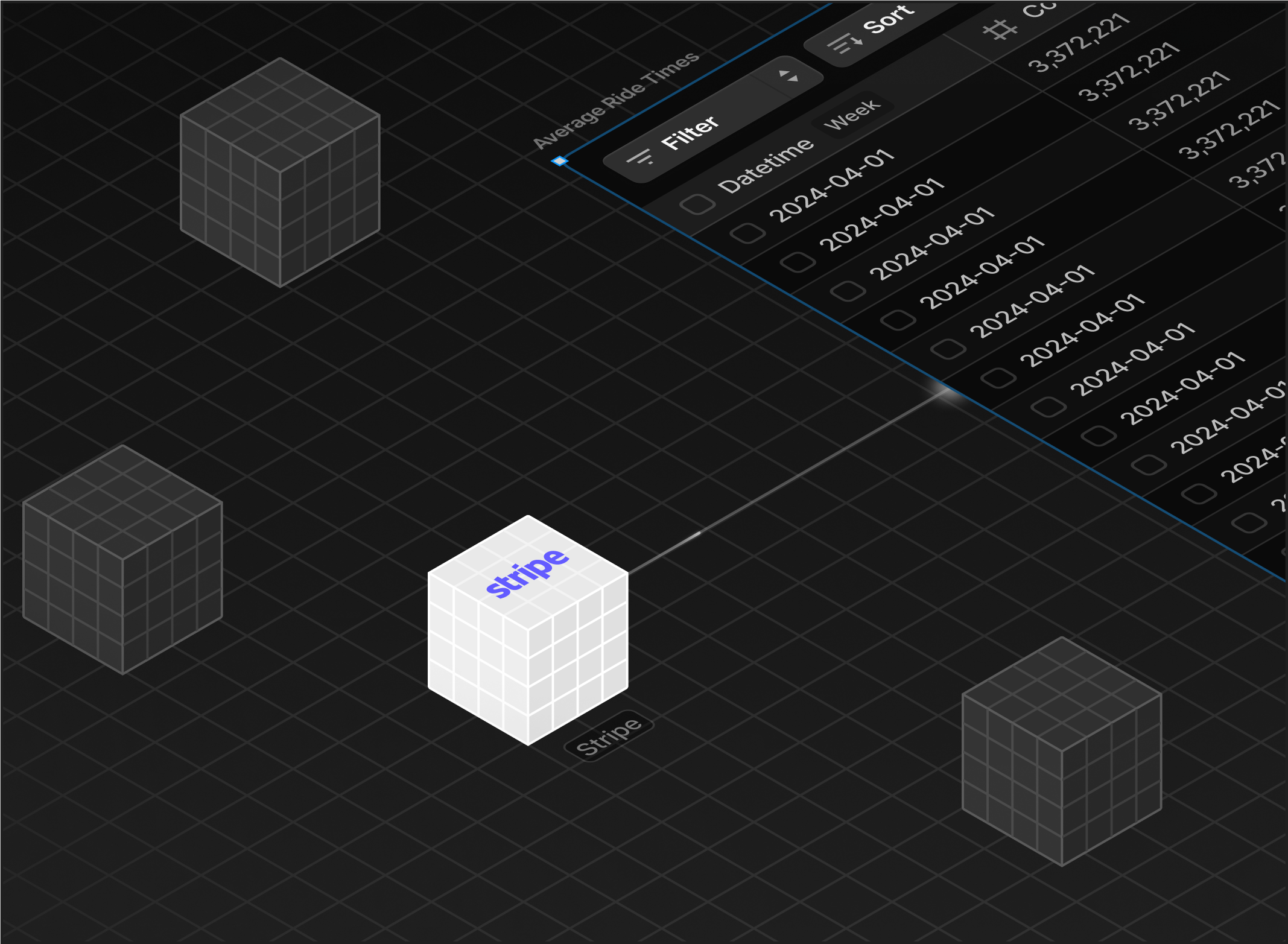Connector Database / Google Analytics
Analyze your Google Analytics data with AI
Build interactive dashboards, generate automated reports, and unlock business intelligence insights from your Google Analytics data with AI-powered assistant.
_

Start with a question
Generate automated reports and business intelligence insights from your Google Analytics data—as fast as you can ask them.


Build dashboards and data visualizations
Transform your conversation into dynamic data visualizations on an intuitive data canvas.
Integrate all your data
Unify your Google Analytics data with DuckDB-powered data warehouse including MongoDB, Google Sheets, Stripe and S3.

Available Google Analytics Data
Google Analytics (GA4) provides reporting data for a specified GA4 property, with fully customizable reports defined by dimensions and metrics. It enables analysis of website and app performance such as users, sessions, engagement, traffic sources, geography, pages/screens, devices, and ecommerce revenue. Default example reports include website_overview, traffic_sources, locations, devices, pages, transactions, and active users over time.
User (Audience)
Represents people interacting with your site or app; enables analysis of active users, new vs returning behavior, audience segments, cohorts, and lifetime value.
Session & Engagement
Represents visits and engagement quality; supports KPIs like sessions, engaged sessions, engagement rate, and average engagement time across dimensions.
Event
Captures user interactions and custom events; enables analysis of event counts, users per event, and event parameters to understand feature usage and behavior.
Conversion
Represents key outcomes marked as conversion events; supports measurement of conversion counts, rates, and attribution across channels, campaigns, and content.
Traffic Source (Acquisition)
Identifies how users and sessions are acquired via source, medium, campaign, and channel; enables campaign performance, ROI, and UTM attribution analysis.
Content (Pages & Screens)
Represents website pages and app screens; supports analysis of views, entrances, exits, landing page performance, and content engagement.
Device & Tech
Describes user devices and technical context such as device category, OS, browser, and app version; enables optimization across platforms and form factors.
Geography
Represents user location by country, region, and city; supports segmentation and performance analysis for localization and regional campaigns.
Ecommerce
Covers purchases, items, revenue, and checkout steps; enables analysis of ecommerce revenue, AOV, item performance, and conversion funnel efficiency.
Authentication Required
Uses your Google account to securely connect through OAuth 2.0, granting read-only access to your Google Analytics 4 data via the Analytics Data API.
Getting started with
Google Analytics Analytics & Business Intelligence
Connect your Google Analytics data
Connect to Google Analytics once and automatically sync data to your centralized data warehouse for real-time reporting and analytics.
Build business intelligence models
Create automated reports, dashboards, and data visualizations with customizable business logic and AI-powered insights for consistent analytics across your organization.
Generate reports and insights
Create interactive dashboards, automated reports, and data visualizations with AI-powered business intelligence. Share live analytics and scheduled reporting with your team.
Want to see how easy it is to get started?
Google Analytics usersDefinite
People love Definite because it lets you focus on what matters. Setting up your own data infrastructure doesn't make your beer taste better. Skip the tedium and start at analytics.
I was leading the efforts of setting up a business intelligence function. I was surprised how complex this all was to do even today. It's something that every tech company would need at some point but it hasn't been simplified. You need a whole team focused on building a data warehouse, setting up the right pipelines, and then integrating a BI tool on top.Definite wasn't only the answer to this problem, it tackled the next problem I knew I'd have as soon as the BI tool was ready — how do we get non-technical teams and people to learn and utilise such a tool.
Our analytics before Definite consisted of dozens of Excel sheets that took hours to update. Manual updates led to errors. Everyone questioned the accuracy of the numbers. Many people just stopped looking at the reports.After Definite, everything ran like clockwork.We immediately saved thousands of dollars per month in the time spent updating reports and have built strategies (e.g. improved ROI on ad spend, inventory management, etc.) on the data that will yield millions to our bottom line.
Have questions?
Find answers.
Definite has everything you need to deploy analytics within your company.
Data doesn't need to be so hard
Get the new standard in analytics. Sign up below or get in touch and we'll set you up in under 30 minutes.